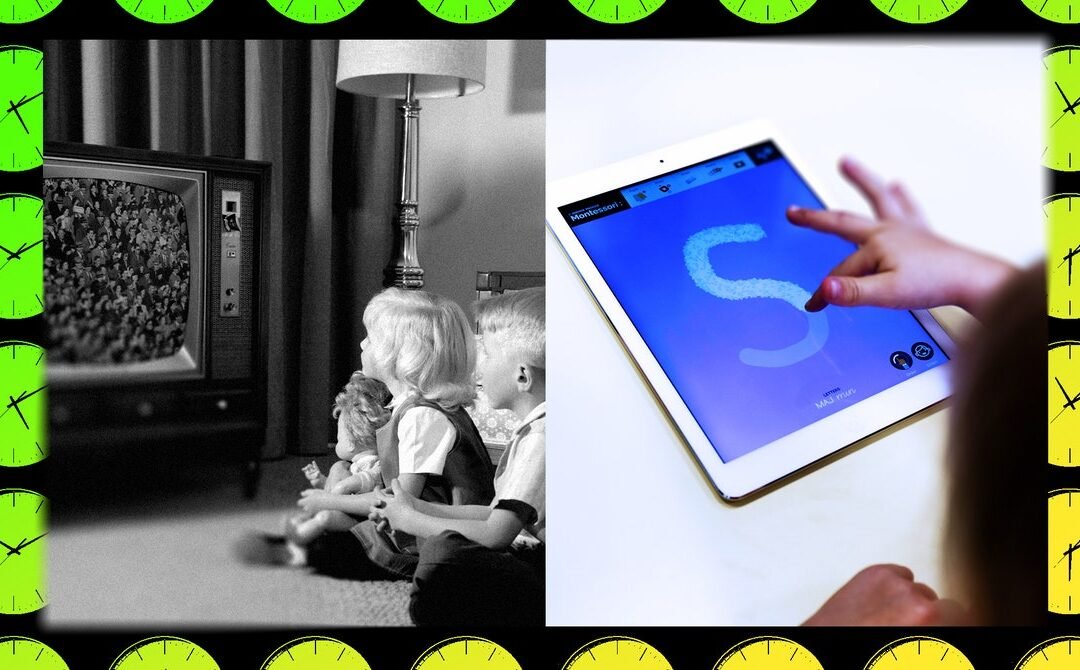
When we drive to Pennsylvania in the summers, with my daughters locked in to their screens for the miles and miles of cornfields and blasted-out hillsides, we drive there to visit the relatives we left behind. In the parlance of our times, we take these trips for face-to-face, or F2F, contact. For my 7-year-old Maeve to rustle her Gram’s many German shepherds, for her 3-year-old sister, Phoebe, to climb on her Grandpa Foo’s back, for the both of them to fall into a real pile with their Uncle Ian and Aunt Lolo. But, for the vast majority of the year, Maeve and Phoebe and their Philly family talk on FaceTime.
It’s very difficult to understate the degree to which I specifically did not believe that video phone technology would ever be a thing. Like a lot of aspirationally pretentious suburban teenagers, I went through a period of twee Luddism in the late 1990s. Inspired by the Beastie Boys, I bought dozens of vinyl LPs for 99 cents a piece, I made a cut-and-paste zine about indie music called The Electric Soul Potato[e] with my friends, I asked for and received a manual typewriter for Christmas. These were the broad trends of the thrifted-cardigan-over-gas-station-attendant-shirt-wearing white boys in my demographic, but my analog aesthetic was, for a time, animated by a genuine pessimism about technology in general. Partially as a stylistic choice, and partially as a real belief, I remember very casually talking about the silliness of striving toward things like voice activation, digital navigation, and, importantly, video phones. In the ’90s, my vision of the future was one in which millions of dollars would be spent trying to perfect marginally useful Jetsons-inspired technology that would never ever really work.
It only now occurs to me that this popular culture of tech backlash, of which I was a teen devotee, was itself a phenomenon of the screen time era. The phrase screen time emerged as a meme to scare parents about the dangers of Too Much TV for little kids. The term, in its current form, originates in a 1991 Mother Jones article by the opinion columnist Tom Engelhardt. Previously, screen time had referred to how much time an actor appeared onscreen in TV and movies. But Engelhardt, in “The Primal Screen,” reversed the term’s meaning. Screen time wasn’t a measure of what happened on the screen; it was a metric evaluating us.
In the intervening decades, that definition has become definitive. For parents, guesstimating and regulating kids’ screen time is now a huge part of the job. Whether taking a hardline or agnostic position, it’s become a central facet of modern childrearing, a choice like deciding whether to raise kids religious or when to allow them to get their ears pierced. How much is too much? What are they watching when I’m not paying attention? What might they see? Who might see them? We worry about what our kids watch; we worry about what might be in our screens watching them.
The teenagers who, like me, brought their antique Olivetti typewriters to coffee shops to write Vonnegut-esque short stories are the same teenagers whose youths were the first to be governed by this particular parenting movement. We were the kids who were told screens were bad for them, who had TV banned, or who overindulged in response. Though I doubt anybody in this group would have listed obedience to parents as a particularly high priority, it strikes me that at least a part of this allergic reaction to slick digital technology—technology that Apple was making slicker and slicker by the day in ways that would eventually tempt us away from our tech-free purity—was about having grown up within a cultural moment defined by the villainization of screens. Maturity means the ability to discern.
But my teenage self was wrong, it turns out. FaceTime, at least, works. Or, rather, the technology of FaceTime works. The user experience can be a little buggy.
There have been several stages to the girls’ use of FaceTime. The first stage was the easiest. The child—Maeve in this case—is a small, swaddled dumpling. My partner Mel could call her mom or her sister and, magically, have an ordinary conversation, with a live feed of Maeve onscreen instead of her own face. What if I told you that you could talk to your own daughter but see only an uninterrupted video of your infant granddaughter? The future is now! This is the excellent deal that Gram cut in those early days. But then Maeve got squirmy, a troubling wrinkle in our FaceTime dynamic: We couldn’t keep her onscreen.
From there, Maeve ascended to late toddlerhood. She was still squirmy, but with better motor skills and a pliant, inquisitive mind. At that point, the paradigm shift occurred: We just fucking handed her the phone. Her framing instinct was not fully developed just yet, so often these images consisted of the top of her forehead in the bottom of the screen, a roving shot of our ceiling fan, or perhaps just a close-up of her nostril. But, without indulging in too much ageism here, her grandparents were not all that much better. This was especially true of her GG Pap, my grandfather, who was still around and always eager to pick up his iPhone when Maeve called. (Even now, years after he passed, his contact is listed in my phone as “iGrandpa.”) One of the most enduring images I can conjure of him is of a 4-year-old Maeve gabbing jubilantly about nursery school while holding a phone that showed a screen image of my Grandpa’s right eye with an inset image of Maeve’s right eye. Looking out, looking in.

